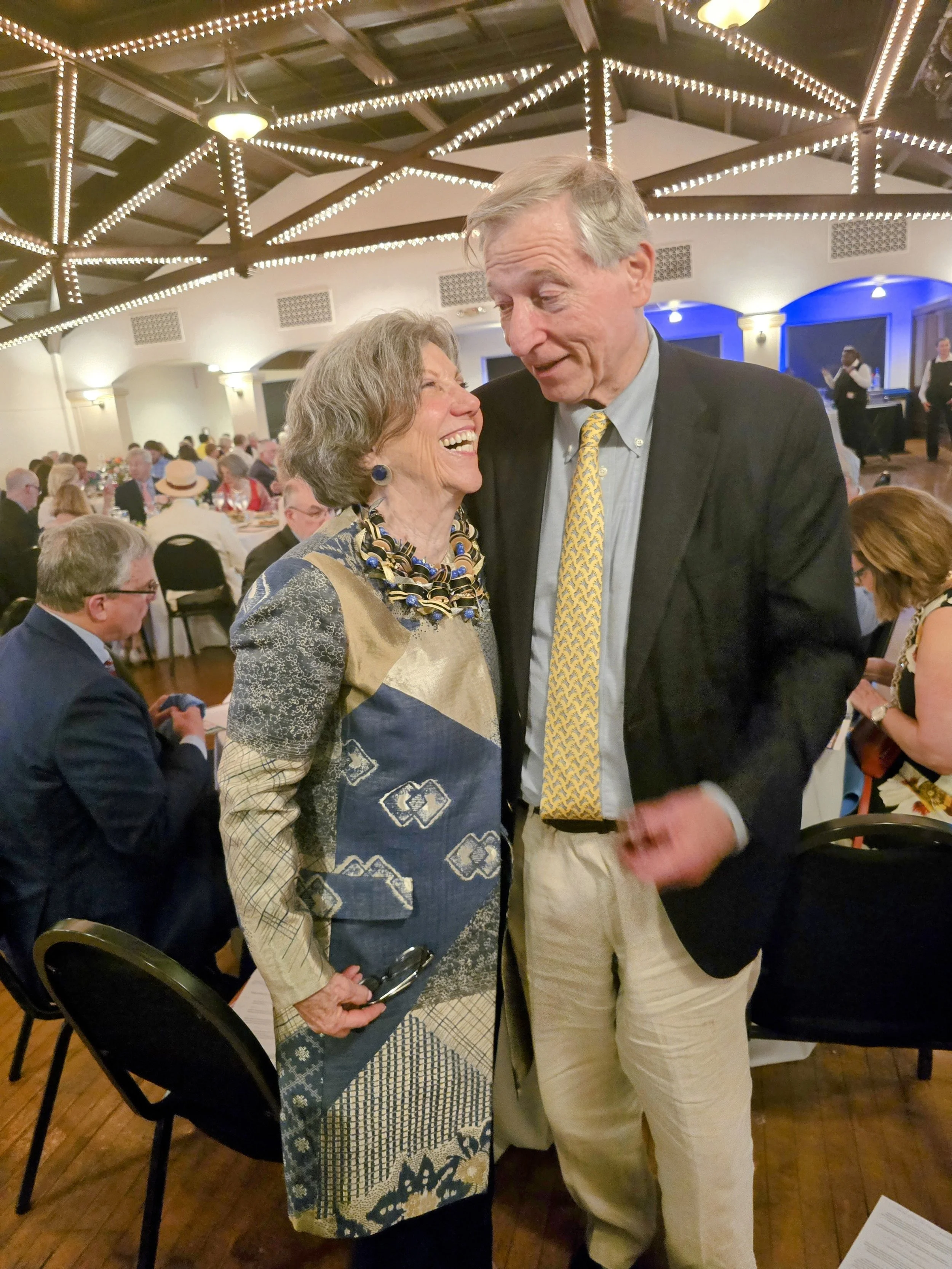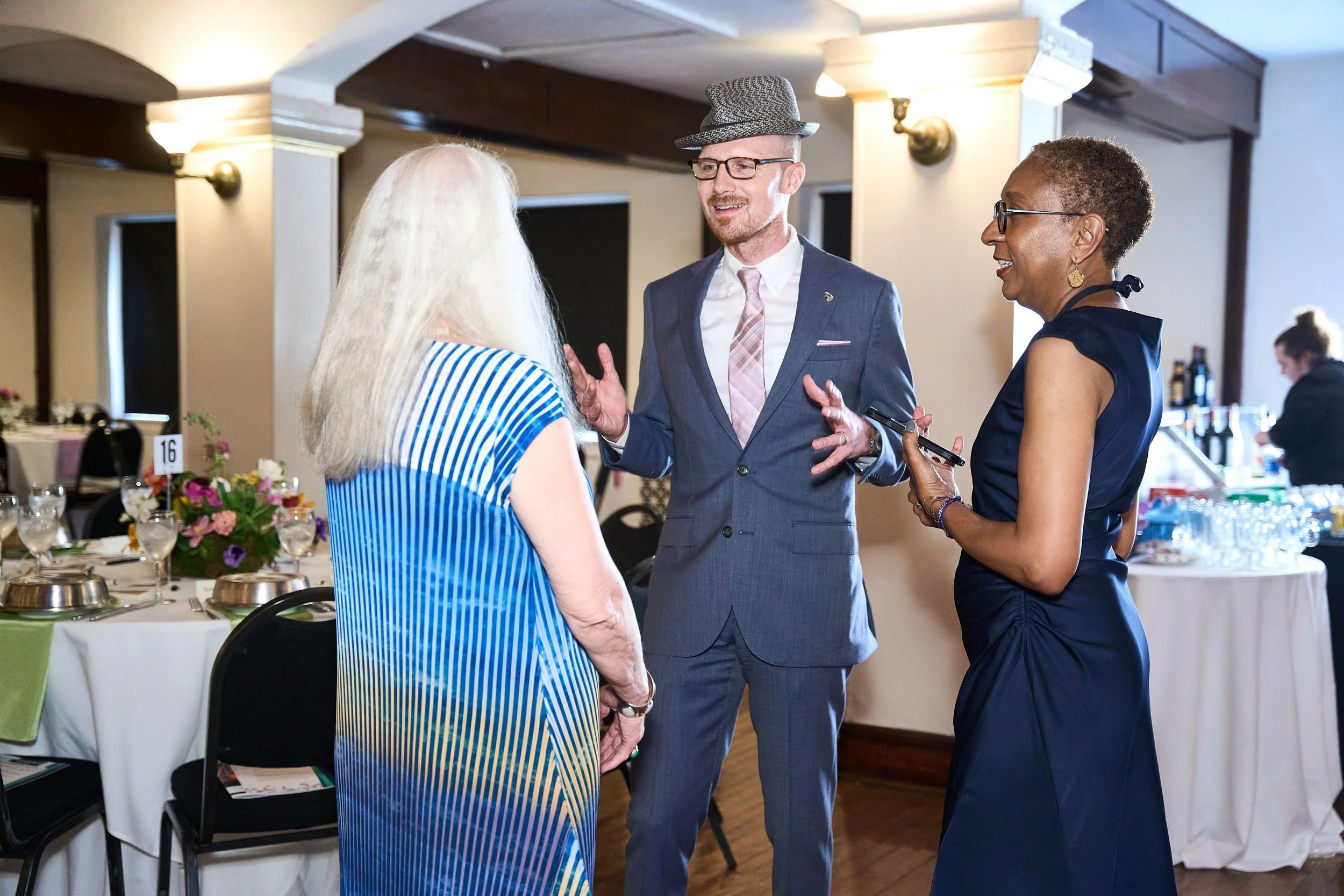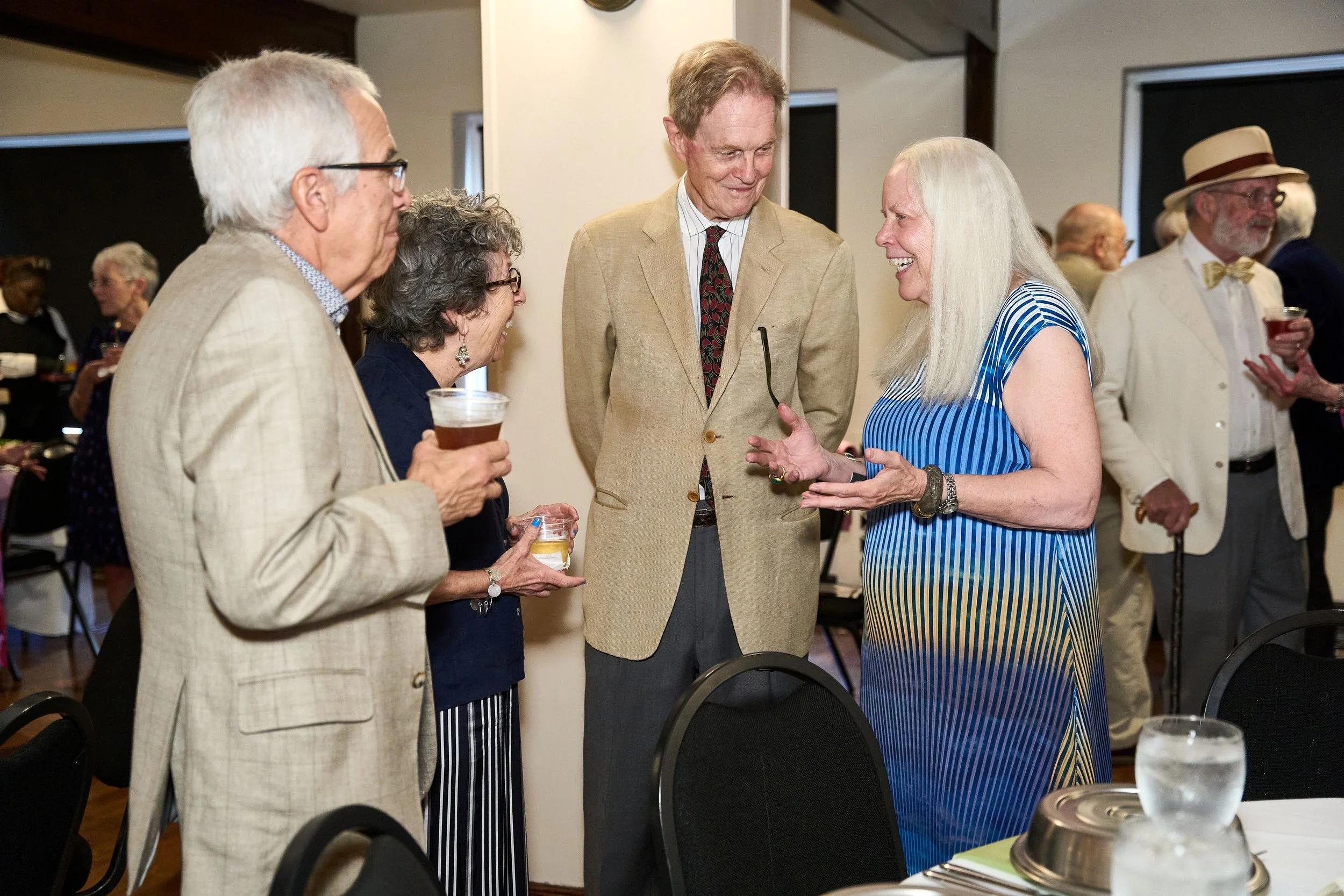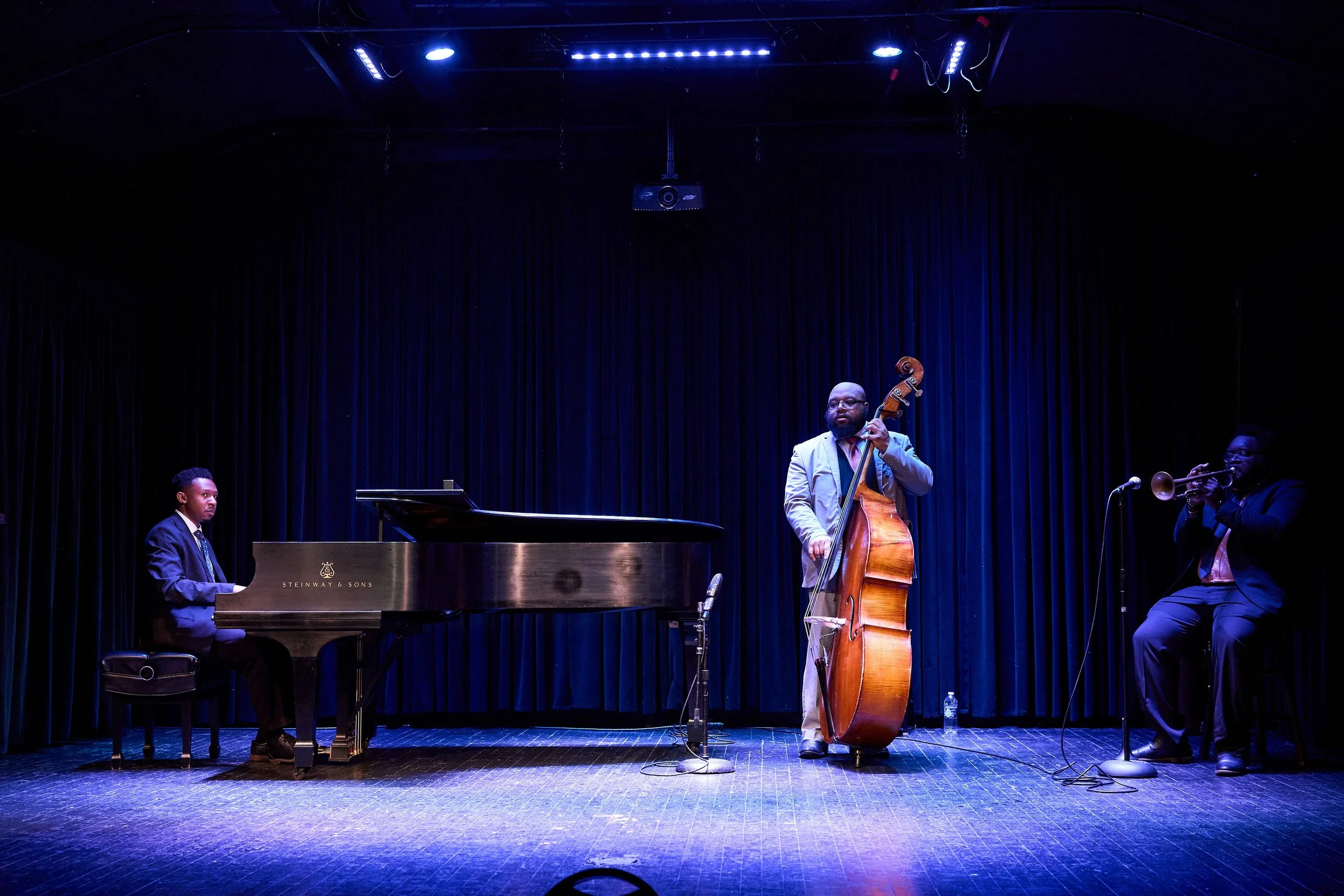Though the Tempest Raged, the Show Must Go On
The Shakespeare Festival St. Louis Celebrated 25 Years One Day; EF3 Tornado Winds Struck the Next.
by Grayling Holmes / photos by Theo Welling unless otherwise noted.
EF3 tornadic winds blew through Shakespeare Glen in Forest Park and struck the newly-constructed stage of “Hamlet.” / photo by Tom Ridgley
Though the winds of the devastating May 16, 2025, EF3 tornado swept through Shakespeare Glen in Forest Park, the show must go on. Though nature struck the newly-constructed stage of “Hamlet,” the show must go on. Though like storm Prospero wrought in Shakespeare’s play “The Tempest,” this VERY real storm raged a 23-mile path of tornadic violence a mile wide. The deadly St. Louis tempest originated in the Clayton/Richmond Heights area, then ravaged Forest Park, uprooting mighty 100-year old trees, and toppling the stage. It then went to the nearby Central West End, and pummeled the North St. Louis Ville neighborhood before jumping the Mississippi to wreak more havoc into Granite City and SIUE in Illinois. Though it leveled buildings, the catastrophe did not level the indefatigable spirit of the city and its people – more than ever the arts can blow in and soothe with azure blue skies and uplifting words…the show must and will go on.
Click on the story. See the damage caused to the Zoo and Shakespeare Glen as the May 16, 2025 ripped up the “Hamlet” set. The set has since been rebuilt in time for the May 28th opening night.
On Wednesday, May 28, 2025, just weeks after the tragedy, lovers of the Bard, legions strong will once again march across the verdant green grass of the forest in the heart of St. Louis. They will come once again, as they have been for 25 years, to see the next quarter century of the Festival begin. The city will rise. The city which embraces the arts will once again begin to heal. Now that the winds have subsided, thousands upon thousands of the community will gather to begin a new season and to celebrate the past 25 years of such artistic gatherings.
St. Louis Shakespeare Festival Producing Artistic Director Tom Ridgely enthusiastically spoke to the gathered crowd at the 25th Anniversary Gala on May 15, 2025.
Celebrate they did the day before the storm hit under the storied rafters of the Sheldon Concert Hall. Nestled in the Grand Arts District at the Sheldon, on the evening of May 15th, hundreds of supporters gathered to break bread together. “It fills my heart that what began in 1998 with a gathering of board members, many of whom sit in this room tonight, has endured and grown as we travel through the new millennium,” said Lana Pepper, one of the founders of the St. Louis Shakespeare Festival. She remembers how just after finishing her Lindenwood University MBA in directing, she was plucked by “STL Shakes” (as the group is sometimes called) Founding Father Crosby Kemper.
“Ok, after graduation, my phone rings and this stranger said, ‘Hi, I’m Annabeth Calkins from the parks department, and was told that I should call you to help organize the Shakespeare Festival in the park. How about we meet for coffee tomorrow?’ Well, that was perfect timing for me right out of school,” remembers Lana. “When I got to the coffee shop, there sat Crosby. He had moved here from Kansas City, and they had a festival there. He was inspired by theirs to start one here. He hired me on the spot, but there was no title, no money and no office. So, for two years all meetings took place in my house. That whole time we were creating a buzz, getting donations, talking to corporations,” she continued. “You know what’s amazing? We hadn’t done anything yet, so people didn’t know if we were going to be amateur hour or not, but for some reason they trusted us to be professional. And so, we started getting donations even though they didn’t know what our product was. That’s how much St. Louis believed in the arts.”
Lana Pepper and Crosby Kemper / photo by Grayling Holmes
For years she worked unpaid to help bring Crosby’s initiative to St. Louis and make it flourish as it had in other cities. “I had a little ‘traveling circus,” she recalled with a smile in her voice. My goal was to create excitement about the potential festival. I traveled around town. I went to every group, every rotary club, every business board, every place that I could think of to tell them what was going to happen that hasn't happened…yet,” she said.
“It will happen, I said, and I want you to know about it,” she said as she traveled around the metro and spread the word.
The gathered tribe at the gala laid testament to the fact that St. Louis is indeed an arts city. And like in the years preceding the year 2001, when the Festival officially began, St. Louisans continue to believe – to believe in the arts. The hundreds gathered at the gala opened their pocketbooks just to buy a ticket to the event. That alone raised a pretty penny. Those pennies go a long way to ensure that the Festival remains free. Unlike some other cities, the St. Louis Shakespeare Festival is free, not only in the park, but for Shakespeare in the Streets, sundry educational programs, and plays formed throughout the region.
Enter Robert Townsend, former producing director, stage left. “Lana had worked behind the scenes getting all the ducks in a row since 1998. She was the first managing director, making all the links from the city to Forest Park and so forth. I came on in the fall of 2001, and at that time, the board said here is what we would like to do and spelled out exactly what the project was to be. They told me what the budget was. I responded, ok. I knew enough people to make stuff happen without a lot of investigation. So, I said, ‘Give me a couple of weeks.’”
Robert came back and told the board that he could do everything they wanted, but it would cost 30% more than the budget they had given him. “I’ll never forget what they said. They asked me to step away from the room for 30 minutes. Upon my return they said, we have good news and bad news. The good news is that you have the money to produce, the bad news is that we want to produce the festival by May.”
The rest is history. “It was an extraordinary labor of love,” he fondly recalled. “It could not be done without passion in such a short timeframe,” he said. “And to this day, I am delighted that the Festival has grown in such importance that the city has embraced it, that people have embraced it, and most importantly, that it has become part of the fabric of the culture of this place we call home.”
At the gala, St. Louis Shakespeare Festival Producing Artistic Director Tom Ridgely enthusiastically spoke about how with broad civic support, the St. Louis Shakespeare Festival has indeed become an institution. “I hope that all of you are feeling proud tonight. Proud of what the Festival’s become, of what it’s doing in the community. Of what it means to St. Louis to have a Shakespeare Festival as strong as and as impactful as this one is.”
Indeed, the Festival has grown into a year-round institution producing over 100 public performances annually and in a typical year reaching 50,000 patrons and students. Performance numbers have grown from 3,000 for Shakespeare Glen in Forest Park, to one summer performance numbers reaching 5,800 attendees. “Our festival can be larger than the one in New York’s Central Park, which has been around longer, but they don’t have open seating. You have to get tickets,” said Lana.
“I had no idea how many people would show up for our first performance in 2001. You put out the word. It had been in the newspapers and other press, but you still don’t know the audience size,” she said. “Because we had no gates there were no restrictions. That was the point of doing it in the Glen. When I saw 3,000 people walk across the Glen that night, it was the most exciting thing in my life; I just couldn't breathe,” she said, still with the breathless way she surely felt that night a quarter century later.
“Funny story about opening night 2001,” regaled Robert. “All right, so I was sitting with my back to the audience, and it was fraught. Everybody’s got a lot of tension and nerves. The director was a young guy named P.J. Paperelli. He was sitting next to me and said, ‘I’m so nervous, you can’t do this tonight. We’re just not ready. It’s just, we can’t do it.’ And I said, ‘P.J., it’s free. You’ve done a great job.’” By that time, Robert had glanced around. He then said to P.J., “Now stand up and look behind you, and there were people streaming into the site, 3,000 in all.”
The two-week initial run of the production of “Romeo and Juliet” attracted 33,000 audience members. That post-Memorial Day weekend performance was and still is for many, to this day, the unofficial start to summer.
Since then, the Festival has grown beyond the perimeters of the park and abounds throughout the summer months into the city. In 2012, the organization debuted “Shakespeare in the Streets,” a collaboration with local neighborhoods to create original productions, blending themes with that community’s unique stories. The boundaries have expanded even more, possibly more than the Festival founders ever thought, even if they were having a midsummer night’s dream.
“As we began to grow past the Glen, we took a small set and put everything into a cargo van, including five actors. We took the show on the road and would do as many as 100 schools in the spring and getting the kids going home enthusiastic about having seen this thing and then bring their families to the Festival,” recalls Robert.
Tom Ridgeley speaks at the “Thinking of Shakespeare Live!” program at the Sheldon Concert Hall after the gala dinner.
Tom takes the festival to ever-widening roads. “We’ve got our big Shakespeare in the Park show in June, and that’s what people know. Then we’ve got a tour that goes all over the region later in the summer. It’s called TourCo and we began that in 2021. It allows us to take the Festival to areas that otherwise have no access to arts programming. We go to dozens of parks, parking lots, and even basketball courts in St. Louis City and County,” said Tom.
“We even do new work. The first one I did was a play called “Into the Breeches,” by George Brant. It was about a group of women who were keeping their local theater going while the men were away holding the breeches. The women, playing both the male and female roles were doing a production of “Henry V,” he said.
“We have tried to make theater relevant to everyone,” Tom said. “We just did a version of “A Christmas Carol” down a the .Zack over the holidays. We want to make theater exciting for everyone. This summer we are making Shakespeare relevant and accessible to kids of all ages with a completely new program when we partner with the Saint Louis Zoo.” The show is “Romeo & Zooliet,” featuring life-sized animal puppetry by Michael Curry Design, the designers of Broadway’s “The Lion King” and “Frozen.”
“We try to bring theater to everyone,” said Lana. “We make it easy and welcoming for people who normally don’t go to theater or don’t have the money to buy tickets; there are no barriers.” One of the things she said really stuck with me since I was an English major in college and always had a little trouble with the 16th-century prose of Shakespear’s day. She said that “We have the best actors, many from New York, and they have the skill and craft to convey Shakespeare in a way that makes you understand what that sentence means. The audience may not get every sentence, but if you have very good, skilled actors, they communicate.”
Lana Pepper.
Most importantly, she said, “That’s why the Festival worked and still works. We make sure that people understand.”
Fast forward to May 15th, and Tom told the gala audience that “The Festival is indeed very strong. Financially strong, artistically strong, and strong in purpose. In a time when the theater industry in this country has been contracting dramatically - with dozens of theaters closing, and countless more cutting back, laying off, and otherwise shrinking - the Festival is coming off its biggest and most successful year ever.”
“Blow, winds, and crack your cheeks! Rage! Blow!” King Lear shouts as he endures a storm. St. Louis endured catastrophic winds on May 16th. Many families were impacted directly. Homes were damaged or destroyed. “Even Sumner High School, where our Arts & Activism program is flourishing, was affected because it sits in the Ville neighborhood, one of the hardest hit areas. Trees down all around, damage to the roof and gutters, and even the newly-renovated Aurthur Ashe football field bleachers and gates were blown away at the school. Some homes just blocks away were leveled, roofs were torn off, and some lost their lives,” Tom said with solemnity.
“But we will rise. We will do what we can to help mend St. Louis’ oldest Black high school west of the Mississippi and alma mater to Chuck Berry, Tina Turner, Author Ashe, and countless other luminaries. The festival donated our stage tarps to the Ville ahead of the rain this week. Colin and Blank Slate brought them tents.”
“After opening, hopefully we can do more. We will be donating a portion we collect in the Glen during Hamlet to the “4theVille” fundraising effort.”
Collectively, St. Louis will rise. It takes a village to rebuild. It takes fortitude to wipe the tears away, roll up our sleeves, pick up the bricks, and start anew. Hopefully, all may get a chance to walk through the Glen in the coming weeks this summer, throw down a picnic basket and blanket, and sit under the stars with the Bard and heal a bit. For now, the wind is calm and like a gentle breeze. We can allow the healing to begin that only the arts can bring. And the show, the city, and its people will go on.
25-Year Celebration Of Shakespeare In St. Louis At The Sheldon In Pictures
Photo by Grayling Holmes
Footnote:
To help the extremely hard-hit Ville neighborhood, go to 4theVille The Ville Emergency Hub: https://www.4theville.org/st-louis-tornado-response
To donate to the St. Louis cleanup effort, you can donate supplies to designated drop-off locations or make monetary donations to various organizations. You can also volunteer your time to assist with cleanup and recovery efforts.
Donation Drop-off Locations:
People's Response Hub at O'Fallon Park Rec Complex: 4343 W Florissant Ave, St. Louis.
The Ville Emergency Hub: 4144 Dr Martin Luther King Dr, St. Louis.
Urban League of Metropolitan St. Louis - Headquarters: .
Power Creative: 3221 Oak Hill Ave, St. Louis.
Sikshs of MO: 12125 Lake Meade Ct, St. Louis.
STL Style House: 3701 Lindell Blvd, St. Louis (Monday closed).
Central West End Veterinary Hospital: 4131 Lindell Blvd, St. Louis.
Bolyard's Meat & Provisions: 2733 Sutton Blvd, St. Louis (until June 1).
Home Sweet Home in Maplewood: 10 Sunnen Drive, Suite 100, Maplewood, MO 63143.
Friendly Temple Outreach Center: 6356 Dr. Martin Luther King Dr.
Refresh Community Church: 829 N Hanley Rd.
Urban League: 1408 Kingshighway Blvd.
O'Fallon YMCA: 4343 W. Florissant Ave.
EthicalBodies/TheGoodIsh: 2610 Cherokee St, 63118.
Monetary Donations:
United Way of Greater St. Louis: Visit helpingpeople.org/stormrelief to support storm efforts.
Salvation Army: Visit salarmy.us/middisaster to donate to their efforts.
Gateway Region YMCA: Visit gwrymca.org/gateway-region-ymca-2025-tornado-relief-fund.
St. Louis Community Foundation: Visit stlgives.org/resources/ to support the Gateway Early Childhood Alliance Fund.
Volunteer Opportunities:
United Way of Greater St. Louis: Visit stlvolunteer.org/disaster to register and view current opportunities.
Action St. Louis and For The Culture STL: Sign up online for volunteer opportunities.
St. Louis Early Childhood Tornado Response Team: Sign up online.
To make a tax-deductible donation to the Shakespeare Festival St. Louis, please go to https://stlshakes.my.salesforce-sites.com/donate/?dfId=a0n8a0000089xV1AAI.











































